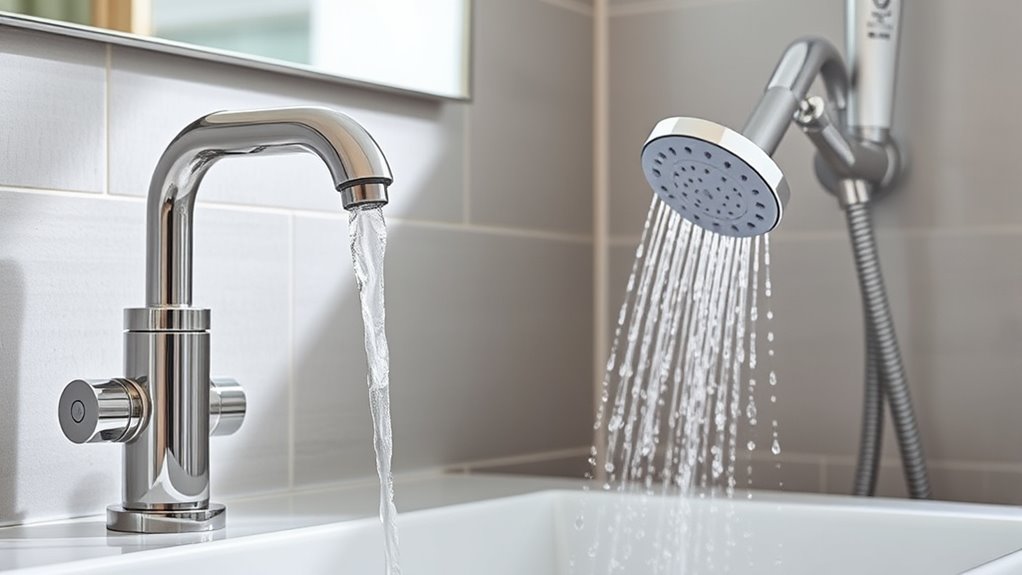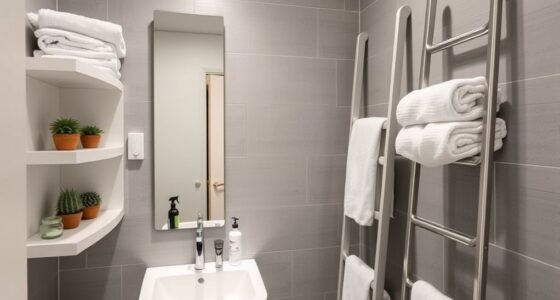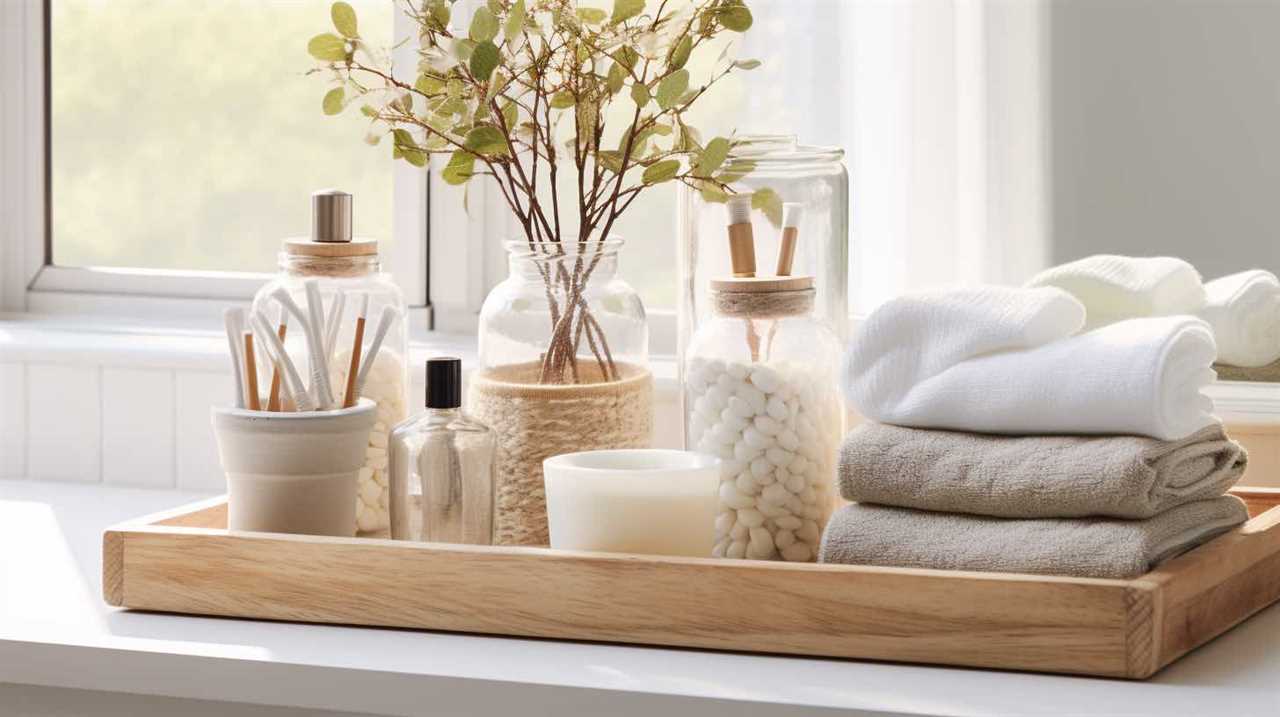When choosing low-flow fixtures, look for models with advanced aerators and flow restrictors designed to maintain strong water pressure. It’s important to guarantee these fixtures are compatible with your existing plumbing and fit your household’s needs. Opt for high-quality options and consider professional installation if needed. By doing so, you’ll enjoy efficient water use without sacrificing performance. Keep exploring to discover more tips for balancing water savings with comfort and effectiveness.
Key Takeaways
- Select low-flow fixtures with aerators or flow restrictors designed to maintain high water pressure.
- Compare product reviews and specifications to ensure models deliver consistent pressure levels.
- Consult professional installers to optimize fixture placement and settings for optimal performance.
- Consider fixtures with adjustable flow rates to balance water efficiency and desired pressure.
- Prioritize high-quality, reputable brands known for reliable low-flow performance without pressure loss.

Switching to low-flow fixtures is an effective way to conserve water and reduce your utility bills. When you’re considering these upgrades, it’s important to think about installation considerations early on. You want fixtures that are compatible with your existing plumbing to avoid costly modifications. Some low-flow models require aerators or specific valve types, so double-check the manufacturer’s instructions and verify your current setup can support the new fixtures. Installing low-flow showerheads or faucets is usually straightforward, but if you’re replacing old fixtures, you might need to adjust water lines or fittings, which could need professional help. By planning ahead, you avoid surprises that could escalate your costs or delay the project.
Plan installation carefully to ensure compatibility and avoid costly modifications when switching to low-flow fixtures.
A key part of deciding whether low-flow fixtures make sense for you involves conducting a thorough cost benefit analysis. While these fixtures tend to be more expensive upfront than traditional models, the savings on water bills can quickly offset the initial investment. Think about your household’s water usage—if you live alone or have a small family, the savings might be less dramatic, but with multiple family members, the reduction in water consumption becomes significant. Also, consider the lifespan of the fixtures; many low-flow options are built to last as long as conventional ones, and some even include features that improve water pressure without increasing flow rates. When you evaluate the costs, include potential rebates or incentives available in your area, which can further reduce the financial burden.
In addition to cost considerations, don’t forget about performance. Many low-flow fixtures are designed to maintain high water pressure despite using less water. Look for models that feature aerators or flow restrictors engineered to optimize pressure and flow, so you don’t feel like you’re sacrificing performance. Reading reviews and testing different models can help you choose fixtures that meet your expectations. Remember, the goal is to save water without sacrificing comfort, so it’s worth investing in quality fixtures known for reliable performance. Vetted information ensures that you select fixtures that are both efficient and dependable.
Ultimately, choosing low-flow fixtures involves balancing installation considerations, upfront costs, and long-term savings. With the right planning, you can enjoy strong water pressure, reduce water waste, and lower your utility bills. Take your time to research options, consider professional installation if needed, and look for models that offer the best value for your budget. When you do it right, these fixtures become a simple, effective way to make your home more eco-friendly and cost-efficient without sacrificing the water pressure you rely on daily.
Frequently Asked Questions
Can Low-Flow Fixtures Increase Water Bill Savings Long-Term?
Yes, low-flow fixtures can boost your water bill savings in the long run. By promoting water conservation, they reduce your overall water usage, leading to lower bills. Plus, many low-flow fixtures are designed for fixture durability, so they last longer and require fewer replacements. This combination helps you save money over time while supporting eco-friendly practices, making them a smart investment for your household.
How Do Low-Flow Fixtures Impact Cleaning Effectiveness?
Low-flow fixtures can slightly impact cleaning effectiveness by reducing water flow, which may affect detergency effects and residue removal. However, modern low-flow fixtures are designed to optimize water pressure, ensuring you still get thorough cleaning. You might need to use a bit more detergent or scrub a little longer, but overall, these fixtures can maintain good cleaning results while conserving water. Just be mindful of adjusting your cleaning methods if needed.
Are Low-Flow Fixtures Suitable for High-Demand Households?
In high-demand households, low-flow fixtures can still be suitable if you select models designed for strong water pressure. They work well in luxury bathrooms, maintaining aesthetic design while conserving water. You might need to choose fixtures with higher flow rates or advanced aerators to meet your needs. With proper selection, you won’t sacrifice performance or style, ensuring your home remains functional and visually appealing.
What Maintenance Is Required for Low-Flow Fixtures?
Think of your low-flow fixtures as a well-loved garden tool—requiring regular care to stay effective. For ideal fixture durability, clean aerators and filters every few months to prevent mineral buildup. Depending on water quality, you might need to check for leaks or corrosion annually. A simple wipe or replacement keeps water pressure steady and extends fixture life, ensuring your eco-friendly choice keeps working smoothly with minimal fuss.
Do Low-Flow Fixtures Comply With Local Building Codes?
You’ll find that most low-flow fixtures do conform with building code regulations, but it’s essential to check local requirements. Building code compliance ensures your fixtures meet safety and efficiency standards. Always verify that the fixtures you select adhere to fixture regulations specific to your area, as codes can vary. Doing this ensures your installation is legal, functional, and sustainable, preventing potential issues down the line.
Conclusion
Choosing low-flow fixtures is like upgrading your garden hose with a high-pressure nozzle—you conserve water but still get a strong, effective spray. I once installed a low-flow showerhead, and at first, I worried about losing pressure. But turns out, it delivered just as satisfying a shower, using 30% less water. With the right fixtures, you can save water and still enjoy plenty of power—proving you don’t have to sacrifice performance for efficiency.











